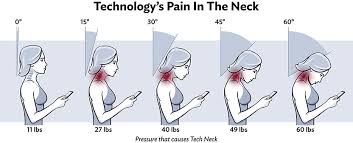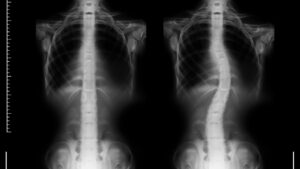Tech neck (also called forward head posture) refers to a condition where the head is positioned forward of the body’s center of gravity, typically due to the prolonged use of technology devices such as smartphones, computers, and tablets. It is a type of poor posture that places strain on the neck, shoulders, and upper back.
Causes of Tech Neck/Forward Head Posture:
Tech neck happens when you spend long hours hunched over a screen, with your head jutting forward instead of being aligned with your spine. This unnatural position shifts the natural curvature of the neck and places stress on the muscles, ligaments, and joints.

Symptoms of Tech Neck:
The forward positioning of the head creates strain and tension, which can lead to a variety of symptoms. Some common signs include:
Neck pain: Muscles in the neck become fatigued from constantly holding the head in a forward position, leading to pain and stiffness.
Headaches: Strain on the muscles of the neck can contribute to tension headaches, particularly at the base of the skull.
Shoulder pain: The shoulder muscles (especially the trapezius) may become tight and sore from compensating for the forward head posture.
Upper back pain: Poor posture and imbalances can lead to discomfort in the upper back, including the thoracic spine.
Fatigue: As the body struggles to support the head, overall muscle fatigue can set in, contributing to discomfort and reduced energy.
Decreased mobility: The neck may become less flexible, and movement may be limited due to tight muscles and poor posture.
How Forward Head Posture Develops
Normally, the head should be aligned directly over the spine. The ears should be in line with the shoulders, with the chin tucked slightly in. When we spend long hours looking down at devices or slouching forward, gravity pulls the head out of its optimal position, causing a forward head posture. For every inch the head moves forward, the strain on the neck muscles and spine increases. The muscles in the front of the neck become overstretched, while the muscles at the back (e.g., upper trapezius and cervical extensors) tighten up, trying to support the extra weight. This imbalance can lead to pain, stiffness, and discomfort in the neck, shoulders, and upper back.
Key causes:
- Prolonged screen time : Using smartphones, tablets, or computers often leads to looking down or leaning forward for extended periods.
- Poor posture: Sitting or standing with shoulders slouched and head forward exacerbates the condition.
- Weak muscles: A lack of muscle strength and stability in the neck, back, and core can contribute to improper posture.
- Poor habits: Sitting in uncomfortable positions or engaging in activities that promote slumping can worsen the condition.
- Lack of ergonomics: Workstations that aren’t designed for proper posture, such as desks too low or screens too far down, increase the likelihood of forward head posture.
How to Fix or Prevent Tech Neck
1) Ergonomic Adjustments Screen at eye level to avoid tilting your head down, adjust chair so feet are flat and knees are at 90°. Use a standing desk to alternate between sitting and standing.
2) Mindful Posture Maintain good posture: Shoulders back, chest open, head aligned with spine. Chin tucks to retrain neck muscles.
3) Regular Breaks Follow the 20-20-20 rule: Every 20 minutes, look at something 20 feet away for 20 seconds. Move every 30-60 minutes to reduce stiffness.
4) Strengthening Exercises Chin tucks: Pull chin back to realign spine. Shoulder blade squeezes to strengthen upper back. Neck stretches: Tilt head side-to-side and forward-backward.
5) Improved Device Usage Hold devices at eye level to prevent looking down. Use voice commands/Bluetooth to reduce phone usage time.



